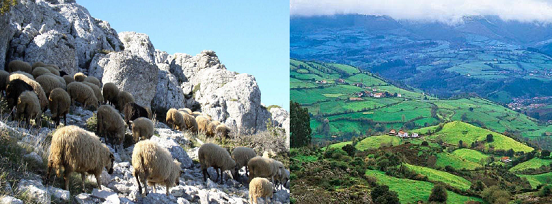
23 de May de 2017
Cambio climático y gestión de recursos naturales
Calidad y cadena alimentaria
The study "Mountain Food Production in Spain" highlights the potential of mountain areas for developing sustainable food systems.
Spain is a country with a high and rugged terrain in many areas, a mountainous terrain compared to the rest of Europe, surpassed only by Switzerland and Austria. Spain's mountain ranges are numerous and occupy almost half of the country's territory. In fact, this study has confirmed that 38% of Spanish municipalities are included in what are defined as "mountain areas" and that they are also distributed throughout all the autonomous communities and 49 of the 50 Spanish provinces.
The purpose of this study is to evaluate the productive potential of mountain foods and the feasibility of using the optional term "mountain product" in Spain. The study highlights that the Spanish mountains have great potential for developing a sustainable food system .
However, this great productive potential does not currently translate into high economic performance in our country compared to other European countries. The reasons for this reality are that mountain production systems cannot be massively mechanized, as has been the case in flat, irrigated areas, which thus become a source of strong competition. Other obstacles include a lack of generational renewal and the unclear identification of mountain products in the market . These problems have resulted in poor utilization of useful mountain agricultural land and a failure to consider their products as a guarantee of sustainability and quality .
Mountain municipalities have agriculture and livestock farming that produce quality food , while promoting the protection and conservation of mountainous natural environments and biodiversity. They house and contribute to the economic and social development of the people who live there, addressing the abandonment and depopulation of these territories. In this way, highlighting their products will always help to enhance the role played by mountain livestock and agriculture and ensure their continuity.
The study, available at this link , was conducted by the Ministry in collaboration with Mensa Cívica .
Mountain product
In 2014, the European Union published Delegated Regulation (EU) No. 665/2014 of the European Parliament and of the Council , establishing the conditions for using the optional quality term "mountain product." With this initiative, Europe aims to highlight the value of the products from these regions.
In conducting this study, we identified groups of producers eligible for differentiation through the optional use of the term "mountain product" under this European regulation. The use of this term could serve as a guarantee of protection and promotion for these products, as well as increase their added value , based primarily on aspects of quality, biodiversity, and territory.
In other European countries, such as Switzerland, France, and Italy, "mountain products" are already being used, subject to national regulations governing their use in order to increase transparency for consumers and ensure that all stages of production and processing of these products have been carried out in mountain areas.
The sources used to carry out this work were, firstly, data obtained through the participation of producer groups, federations, associations (such as the Spanish Association of Mountain Municipalities ), researchers, local action groups in each autonomous community, and central, regional, and local administrations . One of the most widely used instruments for collecting and systematizing information has been several surveys addressed to regional agriculture, livestock, and rural development administrations, as well as to producers of mountain foods that meet the requirements established by the European Union for the use of the optional quality term "mountain product."
Among the objectives of this work is also to develop a database that will allow for an assessment of the status of mountain products in Spain in order to prepare submissions to the European Union's Green Procurement Specifications, which will be published in mid-2017.









